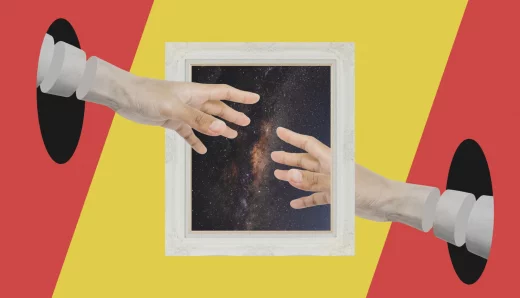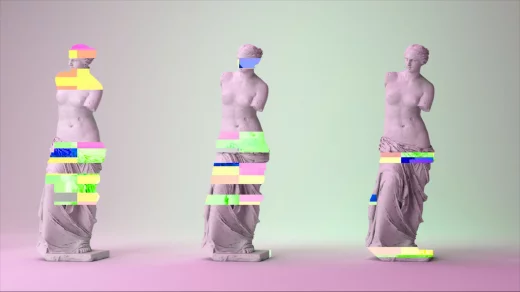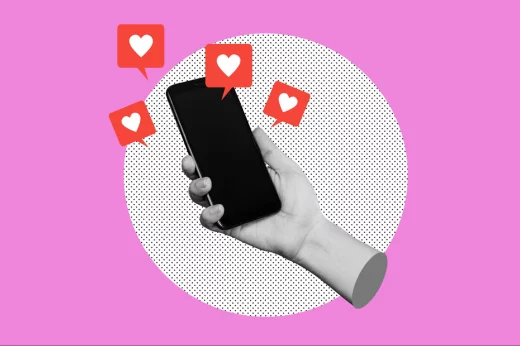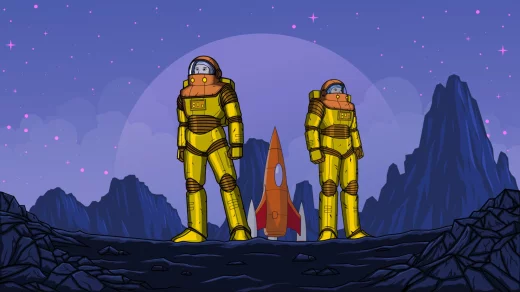
Introduction to Selling Digital Art
If you’re a digital artist, then you know that the playing field for creatives on the internet has changed forever in 2023.
Your work is now accessible by millions with a click of a button. There’s an entire sea of new art being poured onto online platforms on a daily basis and that raises a question – how can you turn your work into profits? How do you make your art stand out? The answer lies in understanding how to sell digital art.
With the advent of NFTs, art platforms and other technologies, the digital art market has become more competitive than ever. However, at the same time, it now offers innovative new ways for new artists to scale their income and turn their art into reliable businesses.
In this article, we’ll deep dive into the world of digital art. We’ll talk about tips on how to create great works of art all the way to promoting and marketing them. We’ll talk about NFTs, platforms to sell art as well as legal considerations.
Let’s get started.
Understanding the Market for Digital Art

Before we dive into selling digital art, let’s talk about understanding the market and what collectors are looking for. How do collectors make buying decisions?
The digital art market is diverse. It has a wide variety of different art styles, genres and types. In addition, there are dozens of platforms that artists use today to sell art and various formats including NFTs.
However, one of the most important factors is the “perceived value” of a piece of art – this value is created through promotion and branding by the artist. Your choice of platform greatly affects this perceived value, as every platform serves a different type of purpose and a different kind of audience. Choose it wisely.
Another trend in the market is the increasing demand for unique and limited-edition pieces. Collectors are willing to pay a premium for art that is rare or one-of-a-kind – this is where NFTs come into play.
NFTs, or non-fungible tokens, are a type of digital asset that represents ownership of a unique item or piece of content.
The Advent of NFT Technology and Why You Should Care

The successes of NFT projects continue to inspire. Recently, they've taken the art world by storm. According to blockchain data company Chainanalysis, the NFT market has reached over $40 billion in value and continues to grow.
In addition to giving artists a new way to sell their work, NFTs add a new dimension to the “perceived value” principle. They provide collectors the ability to prove ownership and scarcity.
If you don’t know already, NFTs are created using blockchain technology, the same technology behind cryptocurrencies like Bitcoin and Ethereum. When an artist creates an NFT, they're essentially minting a digital certificate and placing it onto a blockchain. This digital certificate is linked to their artwork which is publicly verifiable.
This certificate can be bought, sold, and traded on an NFT marketplace. The advent of NFTs has made it easy-peasy for digital artists to sell their work, claim ownership and earn profits. Artists are making millions for single pieces of NFTs simply because of their reputation and “perceived value” among collectors (and despite the decline in NFT sales in the market).
Basically, modern artists get to do what art galleries, collectors and top classical artists have been doing for centuries. In the past, this was only available to privileged artists or those with great standing among collectors. Now, anyone can promote their art using technology.
And not only through some famous art galleries or a handful of collectors – but in front of worldwide audiences, collectors and traders on the internet.
The Role of Platforms in Creating the Ideal “Perceived Value”
As mentioned earlier, each art platform serves a purpose. More or less, every platform has similar features such as posting your work, collecting payments, creating promotional events and so on.
However, each platform serves a particular audience type and creates a specific type of “perceived value” based on the reputation it has garnered over its life.
For example, OpenSea is one of the biggest and oldest NFT platforms that is popular among artists looking to reach a mass audience. They have lower rates and allow transactions in Polygon (as opposed to Ethereum) to save gas fees. Basically, this platform is perfect for those who are looking to sell many NFTs, supposedly at a lower price to attract as many mass buyers as possible.
OpenSea also serves as a decent intermediary. Basically, you promote your work elsewhere, for example, on social media, and use OpenSea primarily as a way to collect payments and showcase your work.
On the other hand, there’s Paysenger – a platform that not only serves as an NFT marketplace but also offers a host of social media features. Which means you don’t only use it as an intermediary to sell NFTs, but also create “perceived value” around your work by creating posts, offering exclusive content and subscriptions or by sharing your expertise with potential buyers.
Finally, SuperRare is another platform that positions itself as a “high-end digital art gallery”. What sets SuperRare apart is that it’s very selective about the art in its collections and usually accepts submissions from well-established artists (as opposed to Paysenger, where anyone can submit their work as a creator).
The platform has a distinct review process, where it spends a lot of time evaluating each submission before approving it.
This adds another layer of assurance for collectors, giving them more confidence to make better investment decisions.
Surely, the platform is for those artists who are targeting a smaller audience but looking to make an impact in the upper echelons of the art world (instead of catering to a mass audience).
Again – the choice is yours. Ask yourself, what type of “perceived value” you’d like your work to have?
The Role Social Media Plays (Hint: It’s Not What You Think)

Social media does for your art what galleries have been doing for artists since the dawn of time. However, promoting or branding your work on social media is an art in itself.
Galleries become famous and attract collectors to the works of artists by using special marketing campaigns, by organizing events or by promoting the artists they are in collaboration with.
If you want the independence working on the internet gives you and get the same results as you would working with a famous/big gallery, then you need to brand yourself just how a gallery would.
Platforms like Instagram, Twitter, and Pinterest are essential tools for artists to showcase their work and connect with potential buyers. But don’t think of these platforms primarily as a gateway to connect with buyers.
Buyers are secondary. The “perceived value” of your art always comes first – and social media is an excellent place to communicate your values, instill colors and emotions in the minds of your audiences and showcase your uniqueness.
It’s your own personal gallery – and remember this, the viewing experience at a gallery does not only depend on the art.
Art galleries are designed to instill certain feelings and perceptions in the minds of the visitors. They use special interior design, well-dressed, professional staff, specialist curation, and so on to create a particular impression.
Everything you post on social media, every word you say in the end creates an impression. What kind of impression would you like to create among visitors of your virtual gallery?
What Makes a Project Succeed?
The biggest reason behind why a lot of digital artists don't get popular or achieve their goals is because they end up heading in the wrong direction when marketing their project.
There are a multitude of factors at play that affect your success as a digital artist or especially these days, as an NFT artist. While the art itself is important, your marketing tactics, monetization tools and platform equally determine your chances to succeed.
Certain NFTs do get viral at times without even needing big marketing teams working on them because they enter the market using the right tools.
For instance, simply posting your work on OpenSea or any other NFT marketplace doesn't guarantee sales or exposure. You need a place to showcase your work and bring attention to it.
A lot of artists use Instagram but it's highly competitive these days, now that the NFT market is a lot more mature now than it used to be. A great strategy to promote your NFT and also monetize it is by using Paysenger – it's a platform that has both social monetization features and a built-in NFT marketplace.
Collectors are more wary of what to look out for and they're always looking for new talent on new platforms. Focus on marketing and brand building by using the methods laid out in this article.
The Predictable Road to Success
Treat your digital art just like any business. What does a collector want and why should anyone purchase your work?
In the art world, a lot of collectors don't just purchase art for the sake of art. You need to learn how to create "perceived value" around that art, and position it in a way through branding that will attract your target buyer. To do this, develop a slight detachment to your work and try to think of it as a "product".
When creating such a brand positioning, try to see eye to eye with the buyer – what do they hope to achieve by collecting your work?
In most cases, the buyer is looking to acquire your work in hopes that it will one day skyrocket in value so they can sell it for profit.
How do you create that perception? Through marketing. And marketing doesn't only include talking about your product using flashy slogans or social media content.
It's about the actions you take. For instance, digital artists who demonstrate consistency in their work and presence in their community create a perception that they're in it for the long run.
Attributes such as long-term consistency establish you as an expert.
So play the long game and you will last longer than everyone else until you eventually build a solid reputation in the market.
Success Stories: Artists Who Started Small But Made it Big

You’ve probably heard of Beeple - who became one of the “top three most valuable living artists” after selling his Everydays: The First 5000 Days work for $69.3 million.
Realistically, you should accept that that does not happen often and there were a lot of factors at play behind the success of Beeple.
There are many other artists who might not be making as much as Beeple but are doing really well selling art online.
They employ various strategies that you can use as well in order to scale your art business.
With that being said, here are some artists who have used platforms like eBay, Amazon, Etsy, and Paysenger, in tandem with social media to sell their digital art.
Jaiden Stipp
Jaiden Stipp, or Jasti, according to CryptoArt, amassed just over $1 million for his NFT sales over his career.
He made his debut in 2021 after he sold his first NFT for 20 ETH ($30,377 at the time), establishing himself as a player in the market.
Justin Bodnar
Known as jstngraphics, american artist Justin Bodnar entered the NFT scene in 2021 with his surreal landscape art.
He used his 6+ years of digital experience to earn himself $500,000 in sales. Most of his NFTs are usually minted via SuperRare – a platform that prides itself for having a detailed review process and “premium” works of art.
Grant Yun
An ex-break dancer and med student, Grant Yun’s nostalgic “old school” art made headlines when he sold his work “The Alien” for 136.9 ETH in 2022 ($236,217 at that time) on SuperRare.
Other notable sales in 2023 include “Casa Roja” for 25 ETH ($31,596.50 at the time) and “En Route #7” for 16 ETH ($19,426 at the time) both on OpenSea.
Do This To Promote and Create Digital Art Effectively

Promotion and creation of digital art go hand-in-hand. You can’t become successful without having a good strategy for promotion in place (even if your art is extremely high quality). Here are some tips to help you market yourself and your art effectively:
Find a niche, stick to it
Make sure your art is not all over the place. Focus on one specific style, subject matter, or medium that sets you apart from other artists. If you’re looking to explore other styles, make sure the transition is smooth. People generally look for similar color “emotions” in a particular artist’s work.
Beeple creates surreal, mind-boggling, political pieces that make you feel weird. Grant Yun does nostalgic pieces, with clean, dim colors and Nintendo themes that make you feel warm and cozy. Stick to what makes your work yours.
Build a portfolio that speaks
Your portfolio is not only something that showcases your work. It’s something that instills particular feelings and emotions in your dream buyer’s mind.
It tells stories and speaks volumes about who you are and what you stand for. Basically, the portfolio not only displays your art but also tells the viewer who you are as an individual and what you stand for.
This is where Paysenger comes to play. The platform is perfect to regularly update potential buyers all over the world about your development as an artist.
Before buyers purchase any of your works, they get to view your profile, past works (and how much they sold for), how much attention your work garners from the general public and how well-established you are in the artist community.
It takes time to have the perfect portfolio but you can do it with perfection when you get the ability to interact with the community in a much more personal way on Paysenger.
Network and collaborate with other artists
Engage with fellow artists and collaborate on projects, exhibitions, or online events. You can do this on Paysenger by sending “paid requests” to other artists.
Whatever work you produce together is partially owned by both you and the artists you collaborate with. On Paysenger, collaborations get sealed in the NFT certificate and both parties earn income for producing viral content as well as royalties when a particular artwork gets resold in the future.
In addition, you also benefit from the extra reach and exposure you get by collaborating with a famous artist.
Use social media to its full potential
Share your work on platforms like Instagram, Twitter, and Pinterest to draw attention to yourself. Paysenger does this automatically by “broadcasting” a sale of your NFT or news of your collaboration to worldwide audiences.
It also sends notifications to your followers to invite them to engage with your work (in exchange for tokens). Participate in communities, join events and shows
Most of what classical artists used to do such as art gallery shows, exhibitions and events is done online today. On Paysenger, you can create full hashtag challenges, invite users to art events, start contests and more to show the community that you are an active member.
This builds confidence among collectors and increases the value of your art.
Digital Art Platforms: Which One(s) to Pick?
There’s a difference between how you sell collector pieces (NFTs) and other digital art – such as illustrations, vectors and graphics.
If you’re looking to sell graphics or arts that can be utilized by other artists or companies, put your work on stock marketplaces and libraries such as:
Creative Market
Creative Market is the go-to place for selling vectors, templates, icons, illustrations and other digital assets. You have to generally go through a review process which usually takes a few days before they approve you as an artist.
It’s a big platform with a massive audience, however, they charge a hefty 40% of every sale.It has good ratings for photography, graphic asset sales and 3D.
Etsy
Etsy is well-known for its focus on handmade and unique items, making it a great option for digital artists selling limited-edition prints-on-demand or other physical, tangible art products.
They charge a $0.20 listing fee, a 5% commission on every sale, however, the rates might end up being higher at the end of the day. That’s because Etsy doesn’t take care of shipping.
It has a very big audience – which means that it’ll be harder for you to get noticed and the only way you’ll be generating leads will be through promotion on external platforms.
eBay
eBay’s most sought after feature is its ability to sell digital art in an auction-style format. You can set a starting price for your work and let potential buyers bid against each other, potentially driving up the final sale price.
It works equally well for prints, illustrations and other collector pieces, although NFT functionality is still limited.
NFTs and Crypto Art
Paysenger

Paysenger is a relatively newer platform designed specifically for selling and promoting digital art. With its focus on NFTs, Paysenger allows artists to sell their work as digital collectibles, providing unique opportunities for revenue and exposure.
As mentioned earlier, the NFT market has matured and collectors are turning towards artists who have a reputation in the communities. To benefit artists, Paysenger serves as not only an art sales platform but also a social network where you can market your work and collaborate with other artists.
It lets you turn all of your social media posts into NFTs which can be traded on the platform's built-in NFT marketplace. The main philosophy of the platform is that every piece of content on the internet has value – and using NFT technology, creators or artists can actually cash in that value.
The service uses a unique microtransaction model where creators can earn for selling individual pieces of content or online interactions such as paid messages. All transactions are performed using EGO token – the platform's utility token.
Popular content earns EGO tokens, which raises its value, encouraging brands and users to mint such content into NFTs.
Try Paysenger for iOS, Android or Web.
Rarible
Rarible has had its fair share of infamous NFT sales. The platform, instead of concluding sales in ETH or other cryptocurrencies, uses its native RARI coins. It charges 1% on buyer side and 1% on seller side on every NFT sale.
The platform is probably the most decentralized by nature. It even structures company policy based on community votes.
OpenSea
One of the oldest NFT marketplaces that started back in 2017, OpenSea hosts art, music, trading cards, photography, virtual worlds and much more. It charges a 2.5% transaction fee. A bulk of transactions on OpenSea are concluded in ETH, which means you’ll also have to pay gas fees to miners.
The platform does offer the ability to take Polygon instead so you don’t have to pay additional gas fees, however, you’ll have to put the Polygon logo on your art work.
SuperRare
SuperRare calls itself a “high-end digital art gallery” because it has an extensive review process for each submission. SuperRare claims that investors can invest in NFTs hosted on the platform with more confidence because it spends a lot of time reviewing every submission and its prospects.
The company charges a flat 3% on every transaction from the buyer’s side.
How to Sell Digital Art Through Commissions
Another way to sell your digital art is by taking commission orders from buyers. Commissions involve creating custom artworks for individual clients based on their specific needs and requests.
You can do this easily on Paysenger. Simply set up an artist-creator profile and start taking orders for creating artworks for a price (that you pick). In addition, you can collaborate with other artists as well by sharing your earnings with them. This also allows you to earn some exposure because the final artwork gets posted on both profiles.
When you set up a profile on Paysenger describing what you can do as an artist, people can simply look you up and send requests for art. Whatever you produce, automatically gets turned into an NFT and the ownership gets split between you and the buyer.
For all NFTs that you own in collaboration with someone else, indefinitely earn you royalties for every subsequent resale.
Build a Strong Portfolio
To start taking orders, build a strong portfolio and promote your work so art collectors know what to expect. You can do this easily on Paysenger by creating Profile Posts. Start by posting on your profile some of your current artworks and they get published for everyone to see.
Additionally, every art request you fulfill also gets shown to a mass audience, so everyone knows how much your NFT sold for and who bought it (of course, you can choose to keep this secret if you prefer to do so).
Understanding the costs to create and sell NFTs
Selling NFTs does not come for free. Every platform has costs, and here the main ones you need to be aware of:
- Platform fees: Most NFT platforms charge fees for listing and selling NFTs, which can range from a flat fee to a percentage of the sale price. If you don’t have the budget to pay for a platform just yet, consider using Paysenger that offers these features for free.
- Transaction fees: In addition to transaction fees when completing a sale, most platforms also require you to pay “gas fees” to the Ethereum network (or to other blockchain networks). Transactions on Paysenger are free of gas fees, since it uses its native token called EGO.
- Minting costs: Platforms also charge for minting an NFT (or make you go through long review processes).
- Marketing and promotion: One of the biggest expenses will be marketing, especially if you use traditional social media (for example, Instagram) for promoting your work. That’s because there’s a lot of competition on social media so you have to pay a higher cost per click to find viewers. Paysenger is a newer platform, with very little competition (for now), so you can reach out to new audiences virtually for free.
Conclusion
All in all, as a new entrant in the NFT and digital art market, you will be facing intense competition and might be surprised by the amount of time, effort and money it requires to launch a successful project.
The biggest money-eating part of the project is going to be marketing. If you try platforms like OpenSea, your work might get lost beneath millions of other NFTs unless you have the marketing resources to compete with others.
If you think you might not have the same resources as a big project, try a platform like Paysenger which combines social media marketing as well as NFT marketplace features to help you stand on your feet.
There are many ways to monetize your work on the platform – such as by offering paid on-demand content, collaborating with others or engaging with other people's content.
Make your journey to become a successful digital artist easier on Paysenger. Reach new audiences, collect payments, collaborate with other creators, find your niche and establish yourself as a successful entrepreneur on the world wide web. Download and try it for free today.
